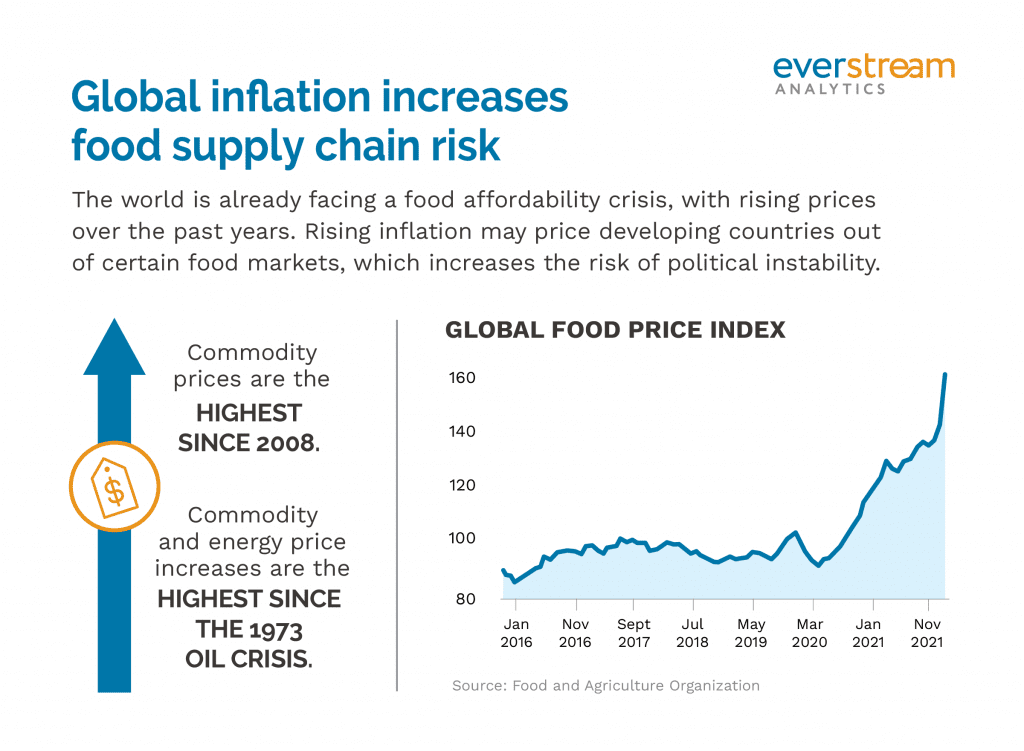Due to ongoing weather, economic and political situations, it is becoming increasingly clear that we may soon be facing some serious global food shortages. With summer in the Northern Hemisphere in sight, these conflicts will likely prevent farmers from collecting bumper crops – which is exactly what we’ll need to keep food insecurity in check.
Here, we’ve highlighted a few key political factors that may keep key food items off the table this year.
Political instability drives shortages
Global events can have a dramatic impact on harvests. For instance, the ongoing war in Ukraine has sharply shifted its status as the breadbasket of Europe.
Ukraine is a highly fertile area, as over half of the country is arable land. Or, put another way, the amount of crop acreage in Ukraine is almost equal to the corn and soybean belt in the U.S. Midwest – the breadbasket of North America. Ukraine’s farmers grow 4% of the world’s corn, 7% of the world’s barley, and 31% of the world’s sunflower oil. And, Ukraine is the 5th largest exporter of wheat. With no clear end to the conflict in sight, futures traders aren’t counting on any significant food production from Ukraine.
This will not only seriously impact Ukraine’s ability to produce and export crops, but also affects food prices around the world.
Food prices have been rising regularly over the past few years in response to various global events, including droughts in the Americas and the strict Covid lockdowns in China. The war in Ukraine will continue this trend, highlighting the ongoing food affordability crisis.

If global food production is further stalled due to bad weather, it could completely price out some countries for certain foods. This could increase the risk of political instability if countries are unable to maintain a comfortable level of food stock for their populations. For example, the main countries that receive Ukrainian wheat exports are Bangladesh, Egypt, Indonesia, and Pakistan, all of which are rapidly growing countries with limited means to prepare for food shortages.
And shortages can create political instability
It’s not just a lack of corn, wheat, and bread that’s causing issues. Commodity and energy price increases are the highest they’ve been since the 1973 oil crisis, and commodity prices alone are the highest they’ve been since 2008.
Indonesia’s recent export ban on processed palm oil shipments, which began at the end of April, has intensified an existing detrimental shortage of global edible oil supplies due to weather and the war in Ukraine. The shortfall in edible oils, as well as heightened food prices, has already provoked significant protests and discontent across the world, including in Sri Lanka, Pakistan, Tunisia, Ethiopia, Ghana, Egypt, and Peru.
Don’t let your business go hungry
As Kristalina Georgieva, IMF Managing Director, notes, “Food insecurity is a grave concern. We must act now with a multilateral initiative to bolster food security. The alternative is dire: more hunger, more poverty, and more social unrest—especially for countries that have struggled to escape fragility and conflict for many years.”
Businesses https://www.everstream.ai/special-reports/food-supply-chain-risk/?utm_medium=everstream-dot-ai&utm_source=blogshould keep a careful eye on weather, political and social events around the world to predict and mitigate delays and shortages. Food insecurity is likely to become worse and countries around the world will grapple with aching stomachs as they scramble for solutions.
See more food risk factors in our infographic. View the infographic.